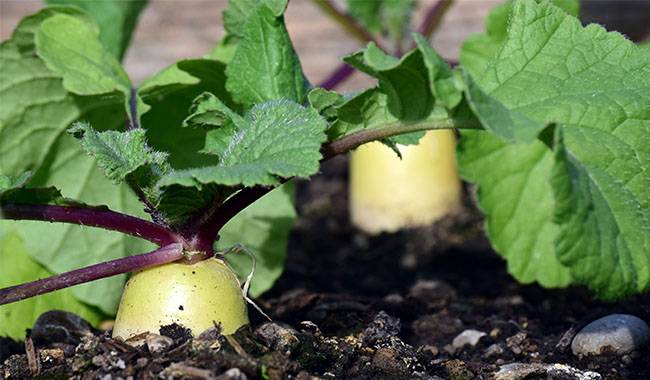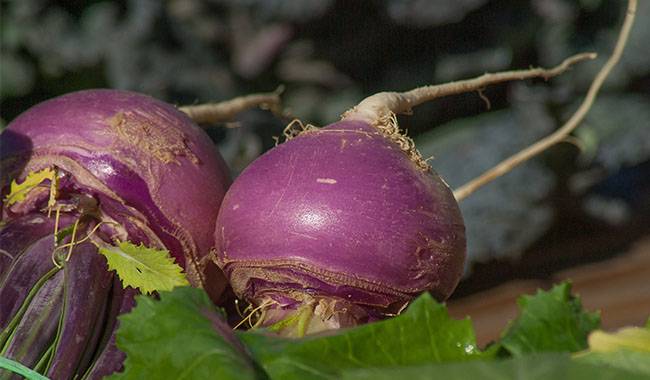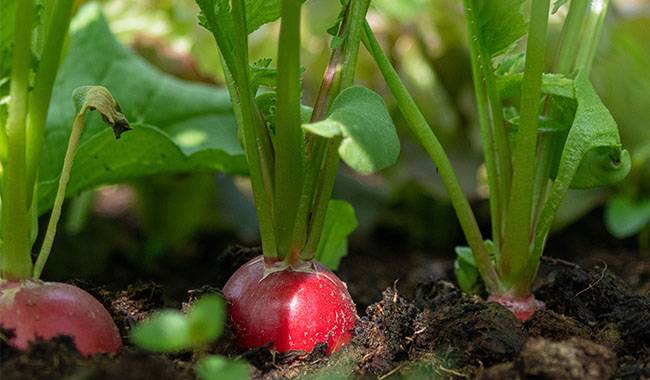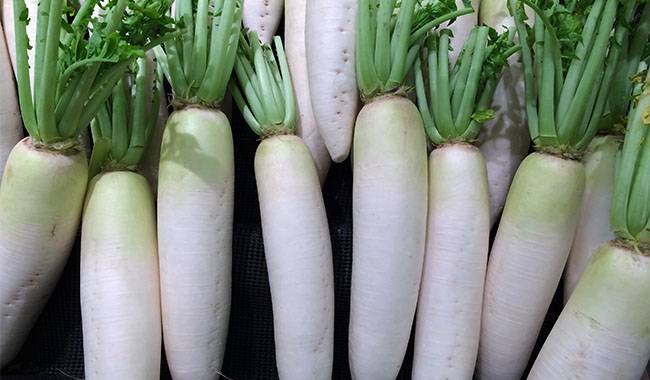
Daikon radish belongs to the cabbage family and is a variety of red radish and Radishes. It is a one to two-year-old crop bred by Japanese breeders from the Asian group of Chinese radish varieties and officially sounds like Raphanus sativus subsp acanthiformis in Latin. Daikon is familiar to Americans for its unusual size, aroma, and flavor, and radish has several translated synonyms that describe its morphological and gustatory qualities: large root, sweet radish, white radish, Japanese radish, Chinese radish, and others.
BIOLOGICAL DESCRIPTION OF DAIKON RADISH PLANT
Radish refers to root crops that are 8-100inch (0.2-2.5m) or larger in size and can weigh more than 176 Lb (80kg). The leaves of Daikon radish are petiolate, dark green in color, and have highly dissected leaves that reach 15-24inch (40-60cm) in length and 6-10inch (15-25cm) in width. 25 cm). The leaves are serrated along the edges, wrinkled, and pubescent or smooth.
The roots of Daikon radish are smooth, have no lateral roots or lenticels, and are white in color. The flesh is white or slightly creamy white and has a pleasant aroma and taste of radish, but not as pungent.
A distinctive feature of Daikon radish is that it does not become woody when overgrown and retains its juicy and pleasant flavor. The mustard oil is mainly present in the rind, and there is no bitter taste of radish when the rhizome is peeled.
In spring planting, Daikon radish germinates rapidly and hardly establishes any rhizomes. With short days, root crop formation is faster, and seed formation is delayed. Under U.S. conditions (Daikon radish can be grown in USDA hardiness zones 2-11), Daikon radish can be sown in the latter part of the summer and cultivated as an annual crop.
BENEFITS OF DAIKON RADISH
Daikon radish is diet food. 300 grams of fresh vegetables provide the daily requirement of vitamin “C.” It is rich in vitamin “B” group, “A,” “E,” “K,” “D.” It contains large amounts of potassium, calcium, phosphorus, magnesium, iron, and other macro and microelements.
Daikon radish rhizome contains isoflavones that inhibit the cancer process. The young leaves of the root crop are used in vitamin salads (the content of vitamin “C” is six times higher than in root crops).
Based on useful properties, Daikon radish should occupy the first place in the ranks of vegetable crops. It is extraordinarily useful for its low-calorie content and quick satiety. Daikon radish is rich in fiber, which is good for cleansing the intestines, liver, and other organs. In its home country, it is widely used to treat acute respiratory infections. Boosts immunity.
Root vegetables help to eliminate cholesterol from the body and have a therapeutic effect on arteriosclerosis, diabetes, and radiation damage. The juice and pulp of Daikon radish are good for clearing acne and freckles from the skin, strengthening the roots of the hair, increasing hair loss, reducing irritability of the nerves, and eliminating insomnia. In case of a severe hangover, the pulp of Daikon radish root is used instead of an antidote.
SPECIFICITY OF DAIKON RADISH CULTIVATION
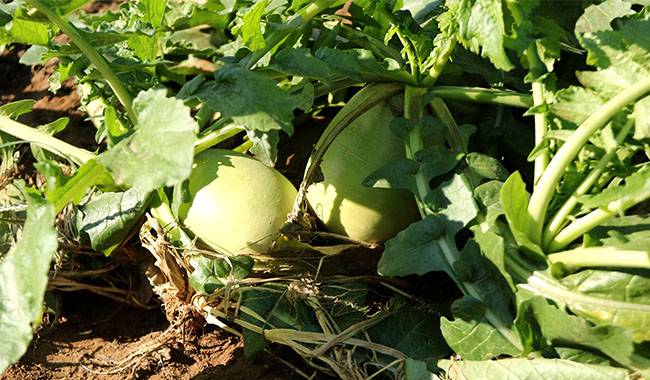
Daikon radish is a simple and unpretentious vegetable crop. Still, due to its biological characteristics, more attention needs to be paid to cultivation methods when growing it, especially sowing time, soil preparation, type of fertilizer, and groundwater level.
Precursors
Daikon radish should not be grown after cruciferous crops. The best predecessors are eggplant, green, and pumpkin crops, including potatoes, tomatoes, zucchini, squash, etc. Daikon radish is neutral to other crops.
Daikon radish sowing time
Daikon radish can be grown by seedling and sowing in the soil, depending on climatic conditions in the U.S. Proper selection of sowing dates will ensure high yields per unit area of root crop, where individual representatives can weigh 4.4-13 Lb (2-6 kg).
Daikon radish can be grown in USDA cold hardiness zones 2-11, and the best sowing dates are June to July. Where black soil zones are available, Daikon radish can be sown in the second decade of July.
Varieties and their maturity dates play an important role. Late sowing can produce a decent yield, but root crops will be small, up to 300-400 g.
Daikon radish varieties
- Miyashige White. This radish is white and has a cylindrical root that grows to 16-18 inches (41-46 cm) long. It has a crisp texture and a mild flavor.
KN-Bravo is a beautiful variety of radish with purple skin and light purple to white flesh. The roots can grow up to 6 inches (15 cm) long and have a slightly sweet flavor. - Alpine. Alpine radishes have short roots and can grow to 5-6 inches (13-15 cm) long. This variety is a popular choice for making kimchi, a fermented vegetable dish, and sweeter than the longer radish varieties.
- watermelon radish. This radish variety has light green skin but reveals bright pink flesh when cut. It is spherical in shape and slightly sweet and peppery.
Japanese Minowase is one of the largest varieties, with roots that grow to 24 inches (61 cm) long. They are white and have a sweet and crunchy taste.
Shunkyo. This cylindrical variety has red skin and white flesh. It grows 4-5 inches (10-12 cm) long and is known for its fiery, sweet flavor and pink stems and leaves.
White radish is native to Asia but is grown all over the world. Varieties include Alpine, KN-Bravo, and Shunkyo. They all have unique shapes, flavors, and colors.
Daikon radish with its environment
Daikon radish is characterized by hardiness, and its seeds germinate easily at 33-37°F (1-3°C). However, it can withstand such low temperatures for a short period of time.
Daikon radish seedlings and adult plants will not be damaged by short-term frosts as low as 24-26°F (-4 to -3°C). When exposed to lower temperatures for longer periods of time, it will stop its growth and development, and if it survives, it will begin to linger.
The optimal temperature for Daikon radish growth and development varies between 53°F (12°C) and 77-80°F (25-27°C). When the temperature rises to 86°F (30°C) or higher, the plant becomes wilted, its immunity is weakened, and it is poorly resistant to pests and diseases.
In drought conditions, Daikon radish forms a bitter-skinned underground portion of the crop with bent roots. Excessive moisture causes the rootstock to crack.
Soil preparation
Daikon radish can be grown on all types of soil, except saline and acidic soils. Before planting, a generous amount of humus and compost should be applied to heavy soil to reduce or eliminate clay (clayey black soil) and increase air permeability. Daikon radish grows best on light soils with deep groundwater, creating high-quality yields.
Soil for Daikon radish is tilled twice in the fall and spring, which is necessary for root growth. In the fall, apply 1 to 3 buckets of humus or mature compost per 35 cubic feet of area. Add 30-50 grams of phosphorus and potassium fertilizer. In the spring, 30-50 grams of ammonium nitro phosphate should be added.
Planting Daikon radish
Daikon radish forms large rhizomes, so it does not tolerate overgrowth. On heavy soils, the best solution is a single row with 10-15inch (25-40 cm) between nests and 15-24inch (40-60 cm) between rows, depending on the variety.
On light soils, a two-row (sometimes three-row) scheme is preferable, with one band 15-24inch (40-60 cm) apart and a maximum of 30-40inch (0.8-1 m) between bands.
Seeding was nested. Sow 2-4 seeds in a nest, stratified 1-2inch (2.5-5 cm). Daikon radish germinates on days 5-7 at normal humidity. Other patterns and spacing can be chosen to suit local climatic conditions better. In normal feeding areas, root crops can reach 24-30inch (60-80 cm) in length and 66 Lb (30 kg) in weight, using usual cultivation techniques.
Care of Daikon radish
Seedlings are thinned at the 1-2 leaf flowering stage. The best-developed plants are left in the nest, and the weaker ones can be replanted (e.g., beet). As Daikon radish grows and develops, another thinning process can be used if the root crop develops properly and establishes itself as a mass. In case of a second thinning, do it at a distance specified in the sowing plan. If Daikon radish is thinned at wisp maturity (or even early), sugar beetroots can be used as a meal. In summer, loosen root crops after irrigation or rain, cover the soil, and eliminate weeds. Support and bind root crops if they protrude strongly from the soil.
Watering Daikon radish
Water Daikon radish as you would a radish. That is, the soil should be moderately moist and free of standing water. Heavy watering after a dry period will result in the formation of ugly, cracked root crops. By the time Daikon radish reaches maturity (2 weeks before harvest), the frequency of watering should be reduced.
Fertilization of Daikon radish
In principle, Daikon radish (especially early varieties) can be grown without fertilizer. A basic dressing before planting is sufficient. However, if the soil is nutrient-poor or moderately fertilized, fertilization is necessary. It is more practical to apply fertilizer in the form of a solution.
- The first fertilization of Daikon radish is done after thinning the seedlings. It is possible to use an infusion of cow dung. The mother liquor is prepared in the following proportions 1/3 of manure per 2.5 Gal (10 liters) bucket and pours water to the top. Infusion is done for 1-2 weeks. The mother liquor is obtained. It was drained, dissolved in a ratio of 1:8, and watered under the roots of the plants. The remaining crude feed is applied as fertilizer under other plants.
- The second fertilization of Daikon radish was done at the beginning of the bale stage. Urea is used. Other fertilizers can also be used, but water-soluble fertilizers containing trace elements are the best. The concentration of the solution is 1-2 tablespoons of fertilizer per bucket of water.
- The third fertilizer (for mid-late and late-maturing varieties) is a comprehensive compound of nitrophosphatide or nitroaminophosphatide in the same concentration as the second fertilizer.
- The fourth fertilizer application for Daikon radish, if desired and necessary, can be made with phosphate fertilizer or phosphorus-potassium fertilizer in 20-30 g/0.25 Gal (1 liter) of water.
The recommended type and amount of fertilizer is presented as an example for novice Daikon radish growers. Experienced gardeners can use their own fertilization program.
PROTECTING DAIKON RADISH FROM PESTS AND DISEASES
- Most often, Daikon radish crops are eaten by cruciferous flea beetles during germination. To protect, cover with mulch after sowing until the 1-2 leaf stage. Pollinate seedlings with ashes (through gauze bags).
- Sprinkle lime, a layer of calcium superphosphate powder, or other simple substances around Daikon radish nests or seedbeds to prevent slugs from scorching the soles of the pests.
- For vegetable fly larvae that gnaw on the roots, preventive spraying with onion-garlic husk mixtures or biological insecticides such as Bitoxybacillin can be done as recommended, preferably in a canned mixture. Spraying with these solutions can be done practically until harvesting.
- As a preventative measure, you can plant marigolds or marigolds in the beds where Daikon radish is planted. Celery or parsley can be planted between the plants in the rows. The smell of these plants is not accepted by cabbage flies and some other pests.
- Daikon radish is resistant to disease and if 1-2 diseased plants appear, remove them from the planting.
HARVESTING AND STORAGE OF DAIKON RADISH
Root crops harvested at the time specified for the variety (40-70 days after germination) can be stored the longest. If harvested early, immature root crops will not store well. Late harvests can be damaged by early frosts. Common in the U.S., the best time to dig Daikon radish is the 2nd or 3rd half of October.
When harvesting Daikon radish on light soils, root crops (especially the small ones) should be pulled with a tractor, while the larger ones should be dug up first and then pulled. Leave them in the bed (and dry out any clumps of soil if necessary).
Trim the traction to a 1-1.2inch (2-3cm) stump.
Wash off the dirt carefully so as not to damage the skin of the roots. Dry Daikon radish in the shade and store it in the refrigerator in a plastic bag, cellar, vegetable pit, or other suitable places for storing vegetables in the sand. Store at a temperature of 32°F to 39-41°F (0 to 4-5°C). Root vegetables can be stored for up to 3 months.
More related information about planting & growing radish plants




